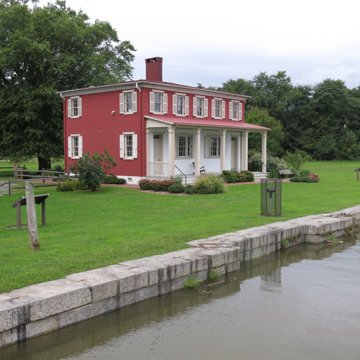This site was built as part of the forty-five-mile Susquehanna and Tidewater Canal, linking Havre de Grace with Wrightsville, Pennsylvania, and a network of interconnected canals extending through Maryland, Pennsylvania, Delaware, New York, and New Jersey. Crucial to the regional economy, the canal provided Havre de Grace exclusive access to goods within Pennsylvania’s agricultural heartland. Its use declined with the coming of the railroads, however, and the canal ceased operations in 1900. While little of the canal remains, this section, along with the lock and lockhouse, has been preserved, and through it, the history of the canal interpreted.
The brick lockhouse sits along the dry-laid, hewn granite canal passage adjacent to a restored lock. More substantial than most lockhouses, it is a handsome Greek Revival building with a low-hipped roof and tripartite windows that flank entrances into the keeper’s residence and the toll-collection office. A porch now shades the canal-facing front, beneath which the red brick walls are whitewashed. The site was given to the city in 1979 and restored in 1982.


